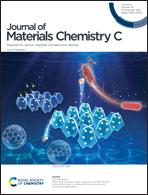Directly written DPP-DTT/SrTiO3 organic/inorganic heterojunctions for anisotropic self-powered photodetectors†
Abstract
The anisotropic electrical properties of organic semiconductors are one of the research hotspots currently. However, there is a great challenge to construct optoelectronic devices by using anisotropic properties of organic semiconductors. Here, we developed anisotropic self-powered photodetectors based on organic polymer semiconducting DPP-DTT and SrTiO3 (DPT/STO) heterojunctions. Two PDs were fabricated where anisotropic DPP-DTT layers were written directly on SrTiO3 with parallel and perpendicular configurations (‖DPT/STO and ⊥DPT/STO). It is found that both devices exhibit anisotropic self-powered characteristics under 400 nm light illumination at zero bias; however, the ‖DPT/STO device shows larger open-circuit voltage (0.71 V) and higher photocurrent (1.0 nA) than the ⊥DPT/STO device (0.26 V and 0.4 nA). Moreover, the anisotropic self-powered feature is also verified on the DPT/GaN devices. The observed phenomenon can be attributed to the anisotropic electrical performance of the directly written DPP-DTT organic polymer. Our work provides a promising way to fabricate anisotropic self-powered devices by employing anisotropic organic semiconductors for broad applications.



 Please wait while we load your content...
Please wait while we load your content...